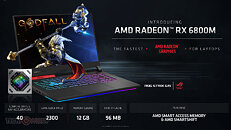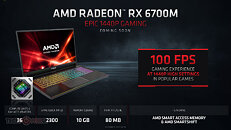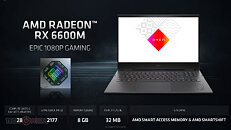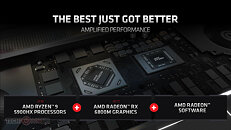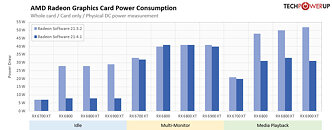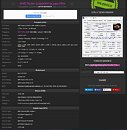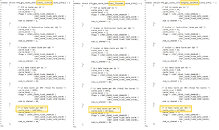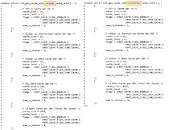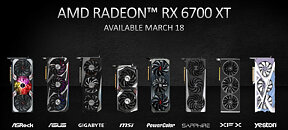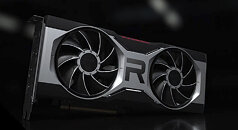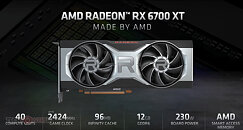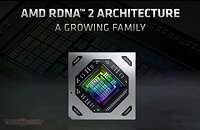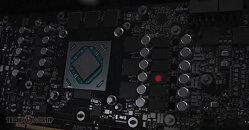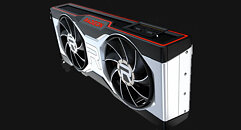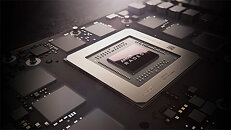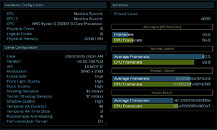Apr 19th, 2025 22:17 EDT
change timezone
Latest GPU Drivers
New Forum Posts
- Recommended PhysX card for 5xxx series? [Is vRAM relevant?] (231)
- [Test Build] Fix for 576.02 Driver Install (28)
- Need thoughts on a quiet PC that's great for rendering, video editing and office work... (5)
- GPU Pricing and Performance (35)
- Folding Pie and Milestones!! (9478)
- Request for advice [Big Build] (3)
- (Some of) What I'd like to See From a Final Fantasy IX Remake (35)
- Pls help me decide on a stop-gap upgrade (CAD currency) (18)
- 12600KF high latency (6)
- Post Your TIMESPY, PCMARK10 & FIRESTRIKE SCORES! (2019) (281)
Popular Reviews
- ASUS GeForce RTX 5060 Ti TUF OC 16 GB Review
- ASRock X870E Taichi Lite Review
- NVIDIA GeForce RTX 5060 Ti PCI-Express x8 Scaling
- Palit GeForce RTX 5060 Ti Infinity 3 16 GB Review
- Teevolution Terra Pro Review
- MSI GeForce RTX 5060 Ti Gaming OC 16 GB Review
- ASUS GeForce RTX 5060 Ti Prime OC 16 GB Review
- Zotac GeForce RTX 5060 Ti AMP 16 GB Review
- MSI GeForce RTX 5060 Ti Gaming Trio OC 16 GB Review
- Sapphire Radeon RX 9070 XT Pulse Review
Controversial News Posts
- NVIDIA GeForce RTX 5060 Ti 16 GB SKU Likely Launching at $499, According to Supply Chain Leak (182)
- NVIDIA Sends MSRP Numbers to Partners: GeForce RTX 5060 Ti 8 GB at $379, RTX 5060 Ti 16 GB at $429 (127)
- NVIDIA Launches GeForce RTX 5060 Series, Beginning with RTX 5060 Ti This Week (110)
- Nintendo Confirms That Switch 2 Joy-Cons Will Not Utilize Hall Effect Stick Technology (105)
- Nintendo Switch 2 Launches June 5 at $449.99 with New Hardware and Games (99)
- Sony Increases the PS5 Pricing in EMEA and ANZ by Around 25 Percent (85)
- NVIDIA PhysX and Flow Made Fully Open-Source (77)
- NVIDIA Pushes GeForce RTX 5060 Ti Launch to Mid-April, RTX 5060 to May (77)
News Posts matching #Navi 22
Return to Keyword Browsing
AMD Retiring Radeon RX 6750 GRE 10 GB SKU According to Chinese Tipsters
AMD's Radeon RX 6750 GRE GPU is an (RDNA 2) Chinese market exclusive—Board Channels members reckon that this model is facing imminent discontinuation. The "GRE" affix denotes "Golden Rabbit Edition." Western graphics card enthusiasts will be familiar with this slightly odd moniker due to Radeon RX 7900 GRE-based (RDNA 3) cards heading to European and North American territories around early 2024. Sadly, this mid-to-high tier GPU is rumored to be reaching an end-of-life (EOL) phase—the latest speculation now points to Team Red's Radeon RX 6750 GRE being quietly withdrawn from China's PC hardware market.
Two Radeon RX 6750 GRE Navi 22-based SKUs—with 10 GB or 12 GB video memory configurations—were created specifically to fill a gap not occupied by AMD's Radeon RX 7600 XT model. The affordable-tier Golden Rabbit Editions are said to be highly popular with Chinese system integrators and budget-minded gamers, but Team Red and its board partners have (apparently) declared that the 10 GB variant is now discontinued. A Board Channel member posited that an "inventory digestion phase" is already underway, with an end date set in March. AIBs are reportedly waiting on "replacement plans from February to March." The Radeon RX 6750 GRE 12 GB variant is reported to be sticking around for the moment, but a new candidate could be appearing in the near future. VideoCardz believes that AMD is considering a rollout of the—not yet announced and oft-delayed—Radeon RX 7650 GRE as a potential modernized substitute.
Two Radeon RX 6750 GRE Navi 22-based SKUs—with 10 GB or 12 GB video memory configurations—were created specifically to fill a gap not occupied by AMD's Radeon RX 7600 XT model. The affordable-tier Golden Rabbit Editions are said to be highly popular with Chinese system integrators and budget-minded gamers, but Team Red and its board partners have (apparently) declared that the 10 GB variant is now discontinued. A Board Channel member posited that an "inventory digestion phase" is already underway, with an end date set in March. AIBs are reportedly waiting on "replacement plans from February to March." The Radeon RX 6750 GRE 12 GB variant is reported to be sticking around for the moment, but a new candidate could be appearing in the near future. VideoCardz believes that AMD is considering a rollout of the—not yet announced and oft-delayed—Radeon RX 7650 GRE as a potential modernized substitute.

AMD Radeon RX 9070 XT Boosts up to 3.10 GHz, Board Power Can Reach up to 330W
AMD's upcoming Radeon RX 9070 XT graphics card can boost its engine clock up to 3.10 GHz, a new leak that surfaced on ChipHell says. Depending on the board design, its total board power can reach up to 330 W, the leak adds. The GPU should come with a very high base frequency for the engine clock, with the leaker claiming a 2.80 GHz base frequency (can be interpreted as Game clocks), with the GPU boosting itself up to 3.10 GHz when the power and thermals permit. The RX 9070 XT will be the fastest graphics card from AMD to be based on its next-generation RDNA 4 graphics architecture. The company isn't targeting the enthusiast segment with this card, but rather the performance segment, where it is expected to go up against NVIDIA's GeForce RTX 5070 series.
RDNA 4 is expected to introduce massive generational gains in ray tracing performance, as AMD is rumored to have significantly developed its ray tracing hardware, to reduce the performance cost of ray tracing. However, as it stands, the "Navi 48" silicon that the RX 9070 XT is based on, is still a performance-segment chip, which succeeds the "Navi 32" and "Navi 22," with a rumored compute unit count of 64, or 4,096 stream processors. Performance-related rumors swing wildly. One set of rumors say that the card's raster graphics performance is in league of the RX 7900 GRE but with ray tracing performance exceeding that of the RX 7900 XTX; while another set of rumors say it beats the RX 7900 XT in raster performance, and sneaks up on the RTX 4080. We'll know for sure in about a month's time.
RDNA 4 is expected to introduce massive generational gains in ray tracing performance, as AMD is rumored to have significantly developed its ray tracing hardware, to reduce the performance cost of ray tracing. However, as it stands, the "Navi 48" silicon that the RX 9070 XT is based on, is still a performance-segment chip, which succeeds the "Navi 32" and "Navi 22," with a rumored compute unit count of 64, or 4,096 stream processors. Performance-related rumors swing wildly. One set of rumors say that the card's raster graphics performance is in league of the RX 7900 GRE but with ray tracing performance exceeding that of the RX 7900 XTX; while another set of rumors say it beats the RX 7900 XT in raster performance, and sneaks up on the RTX 4080. We'll know for sure in about a month's time.

AMD Tightly Regulating Prices of Successful Radeon RX 6750 GRE in China
The AMD Radeon RX 6750 GRE (Golden Rabbit Edition) is a runaway success in China, where the card is found selling in volumes comparable to GeForce RTX 4060 Ti, and the likes. This is thanks to its aggressive pricing, and decent levels of performance given the maturity of drivers for the older RDNA2 graphics architecture. The RX 6750 GRE comes in two variants—a 10 GB variant with a 160-bit memory bus and 2,304 stream processors; and a 12 GB variant with the full 2,560 stream processors, similar to the globally available RX 6750 XT. For AMD, the success of the RX 6750 GRE couldn't have come at a better time, as it looks to mop up its 7 nm wafer allocation with TSMC with the "Navi 22" silicon, which went underutilized as GPU demand fell with the crypto-mining crash of 2022 and the subsequent move to the 5 nm next-generation; and so it needs these cards to sell at prices at least in line with the MSRP, of ¥2,219 (RMB) for the 10 GB variant, and ¥2,379 for the 12 GB model. Apparently some retailers are selling these cards below the MSRP, and AMD isn't liking this.
The way retail works in general, is that when an item is selling below MSRP, it encourages retailers to negotiate lower prices up the supply chain, which would inevitably cut income for AMD, and set off a feedback loop. To check exactly this, AMD rolled out a slew of measures. It will be monitoring the retail channel for retailers selling the card below MSRP, and impose a set of tiered penalties. For the first offense, a retailer will be penalized ¥500 per card sold below MSRP. For the second instance, this penalty goes up to ¥1,000 per card, and a stoppage of supply to the retailer. The RX 6750 GRE is so popular in China that it isn't just AMD's traditional AIB partners selling the SKU, but also several lesser known Chinese brands, which have purchased volumes of the RX 6750 GRE ASIC, and are belting out cards as the market demands. In related news, AMD is yet to launch the new Radeon RX 7600 XT in the Chinese market, because it doesn't want to disturb the flow of the RX 6750 GRE.
The way retail works in general, is that when an item is selling below MSRP, it encourages retailers to negotiate lower prices up the supply chain, which would inevitably cut income for AMD, and set off a feedback loop. To check exactly this, AMD rolled out a slew of measures. It will be monitoring the retail channel for retailers selling the card below MSRP, and impose a set of tiered penalties. For the first offense, a retailer will be penalized ¥500 per card sold below MSRP. For the second instance, this penalty goes up to ¥1,000 per card, and a stoppage of supply to the retailer. The RX 6750 GRE is so popular in China that it isn't just AMD's traditional AIB partners selling the SKU, but also several lesser known Chinese brands, which have purchased volumes of the RX 6750 GRE ASIC, and are belting out cards as the market demands. In related news, AMD is yet to launch the new Radeon RX 7600 XT in the Chinese market, because it doesn't want to disturb the flow of the RX 6750 GRE.

AMD Attempts to Resolve Radeon RX 6750 GRE Supply Issues in China
According to a recent MyDrivers news piece, graphics card models based on AMD's China-exclusive Radeon RX 6750 GRE GPU are "selling like hotcakes" in the region. Team Red's Radeon RX 6750 GRE was released last October, and made available in two memory configurations: 10 GB with a recommended starting price of 2219 RMB (~$312), and 12 GB going for 2379 RMB (~$335). Industry experts were surprised to hear about the mid-range Navi 22 (RDNA 2) GRE card becoming a popular choice in mainstream and budget-conscious gaming circles—as of early January, AMD has taken the unusual step of delaying its Radeon RX 7600 XT launch in China.
Chinese hardware news outlets are reporting that the 12 GB variant is selling for as low as 2239 RMB (~$315) at select retail sites—customers are reported to be snapping these cards up due to an irresistible "price-to-performance ratio," despite onboard technology being almost three years old. AMD is reported to be implementing a "strict" price control policy to prevent unbalanced supply conditions—Wccftech suggests that adjustment "instructions" have been sent out to AIB partners. The MyDrivers article points out that the policy adjustments will take time to stabilize Radeon RX 6750 GRE prices—the aforementioned 2239 RMB shop offers were still live late last week (report is dated January 26).
Chinese hardware news outlets are reporting that the 12 GB variant is selling for as low as 2239 RMB (~$315) at select retail sites—customers are reported to be snapping these cards up due to an irresistible "price-to-performance ratio," despite onboard technology being almost three years old. AMD is reported to be implementing a "strict" price control policy to prevent unbalanced supply conditions—Wccftech suggests that adjustment "instructions" have been sent out to AIB partners. The MyDrivers article points out that the policy adjustments will take time to stabilize Radeon RX 6750 GRE prices—the aforementioned 2239 RMB shop offers were still live late last week (report is dated January 26).

Sapphire Readies Third Variant of Radeon RX 6750 XT GPU
AMD's RDNA3 Navi 32 GPU is reportedly in the works, but PC hardware enthusiasts are getting frustrated with the lack of announcements in regards to Team Red's supposed mid-to-high level "Radeon RX 7700 & 7800 series" card offerings. Current generation options are only available in the form of pricey flagship models - RX 7900 XT and XTX, as well as the recently released lower end RX 7600, with nothing classed as brand new appearing in the middle ground. Notable AMD board partner Sapphire Technology is also getting impatient with this situation and has decided to dip back into RDNA2—technology news site ITHome has discovered that the company is releasing another Radeon RX 6750 XT 12 GB GDDR6 card. This third variant follows previously issued NITRO+ and Pulse models.
Sources have indicated that this new model is called the "Overseas Edition," so it is possible that it will be getting international distribution. Sapphire's custom card has not hit the South East Asia market yet, and the company has not created (at the time of writing) an entry for it on their website or product catalog. ITHome reckons that the Radeon RX 6750 XT Overseas Edition will likely get a retail release to coincide with this week's 618 shopping festival. The card seems to offer a marginal performance advantage (0.9% factory set overclock) over AMD's reference specs—with a 2623 MHz boost clock. It shares the same features as its NITRO+ sibling—namely a Dual BIOS switch and two power connectors.
Sources have indicated that this new model is called the "Overseas Edition," so it is possible that it will be getting international distribution. Sapphire's custom card has not hit the South East Asia market yet, and the company has not created (at the time of writing) an entry for it on their website or product catalog. ITHome reckons that the Radeon RX 6750 XT Overseas Edition will likely get a retail release to coincide with this week's 618 shopping festival. The card seems to offer a marginal performance advantage (0.9% factory set overclock) over AMD's reference specs—with a 2623 MHz boost clock. It shares the same features as its NITRO+ sibling—namely a Dual BIOS switch and two power connectors.

Sapphire Radeon 6700 Graphics Cards Real: No RX, No XT
Sapphire formally launched its Radeon 6700 series graphics card. The AMD Radeon 6700 is an odd-ball SKU that doesn't yet feature in the company's retail product stack, but is yet being released to retail by Sapphire. So far we've not come across any other board partner with this SKU. The 6700 is unique in its branding—there's neither "RX" nor "XT" in the model name, it's called simply the "Radeon 6700."
Carved out from the same 7 nm "Navi 22" silicon as the RX 6700 XT and RX 6750 XT; the 6700 has 36 out of 40 compute units enabled, working out to 2,304 stream processors, and 144 TMUs. The card is endowed with 10 GB of 16 Gbps GDDR6 memory across a 160-bit wide memory interface. Sapphire has two cards in its lineup, one is an unnamed base model that sticks to the "reference" specs, and a factory-overclocked Pulse 6700 card.
Carved out from the same 7 nm "Navi 22" silicon as the RX 6700 XT and RX 6750 XT; the 6700 has 36 out of 40 compute units enabled, working out to 2,304 stream processors, and 144 TMUs. The card is endowed with 10 GB of 16 Gbps GDDR6 memory across a 160-bit wide memory interface. Sapphire has two cards in its lineup, one is an unnamed base model that sticks to the "reference" specs, and a factory-overclocked Pulse 6700 card.

AMD Readies Radeon RX 6700 (non-XT)? Sapphire Custom Design Card Suggests so
AMD is likely preparing to launch a new mid-range graphics card SKU positioned between the Radeon RX 6650 XT and the RX 6700 XT, the new RX 6700 (non-XT). It doesn't seem like the RX 6700 is an OEM-exclusive designed to get rid of silicon. Pictures surfaced of a Sapphire branded custom-design card, complete with box-art designed to woo customers in stores. It also doesn't appear to be a China-exclusive SKU, since Sapphire tends to put Chinese-language branding on its box-art, which is missing here.
The RX 6700 is configured with 2,304 stream processors across 36 RDNA2 compute units, out of the 40 physically present on the "Navi 22" silicon. The memory is an interesting piece of specs, with the RX 6700 coming with 10 GB standard—presumably over a 160-bit wide GDDR6 memory bus. This means five 16 Gbit (2 GB) GDDR6 memory chips. The engine clocks are reportedly 2330 MHz game clock, and 2495 MHz boost; and 16 Gbps memory speed. The cards' board-design is standard Sapphire fare, with nothing that stands out from the current RX 6700 XT Pulse and base-model custom cards from the company. One interesting thing to point out, though, is a single 8-pin connector on the base-model custom card (225 W maximum power capability including the PCIe slot), which should put the typical board power around 200 W. The cards are reportedly launching in Europe on June 9, priced around 569€ including taxes.
The RX 6700 is configured with 2,304 stream processors across 36 RDNA2 compute units, out of the 40 physically present on the "Navi 22" silicon. The memory is an interesting piece of specs, with the RX 6700 coming with 10 GB standard—presumably over a 160-bit wide GDDR6 memory bus. This means five 16 Gbit (2 GB) GDDR6 memory chips. The engine clocks are reportedly 2330 MHz game clock, and 2495 MHz boost; and 16 Gbps memory speed. The cards' board-design is standard Sapphire fare, with nothing that stands out from the current RX 6700 XT Pulse and base-model custom cards from the company. One interesting thing to point out, though, is a single 8-pin connector on the base-model custom card (225 W maximum power capability including the PCIe slot), which should put the typical board power around 200 W. The cards are reportedly launching in Europe on June 9, priced around 569€ including taxes.

Intel Arc DG2-512 Built on TSMC 6nm, Has More Transistors than GA104 and Navi 22
Some interesting technical specifications of the elusive two GPUs behind the Intel Arc "Alchemist" series surfaced. The larger DG2-512 silicon in particular, which forms the base for the Arc 5 and Arc 7 series, is interesting, in that it is larger in every way than the performance-segment ASICs from both NVIDIA and AMD. The table below compares the physical specs of the DG2-512, with the NVIDIA GA104, and the AMD Navi 22. This segment of GPUs has fairly powerful use-cases, including native 1440p gameplay, or playing at 4K with a performance enhancement—something Intel has, in the form of the XeSS.
The DG2-512 is built on the 6 nm TSMC N6 foundry node, the most advanced node among the three GPUs in this class. It has the highest transistor density of 53.4 mTr/mm², and the largest die-area of 406 mm², and the highest transistor-count of 21.7 billion. The Xe-HPG graphics architecture is designed for full DirectX 12 Ultimate feature support, and the DG2-512 dedicated hardware for ray tracing, as well as AI acceleration. The Arc A770M is the fastest product based on this silicon, however, it is a mobile GPU with aggressive power-management characteristic to the form-factor it serves. Here, the DG2-512 has an FP32 throughput of 13.5 TFLOPs, compared to 13.2 TFLOPs of the Navi 22 on the Radeon RX 6700 XT desktop graphics card, and the 21.7 TFLOPs of the GA104 that's maxed out on the GeForce RTX 3070 Ti desktop graphics card.
The DG2-512 is built on the 6 nm TSMC N6 foundry node, the most advanced node among the three GPUs in this class. It has the highest transistor density of 53.4 mTr/mm², and the largest die-area of 406 mm², and the highest transistor-count of 21.7 billion. The Xe-HPG graphics architecture is designed for full DirectX 12 Ultimate feature support, and the DG2-512 dedicated hardware for ray tracing, as well as AI acceleration. The Arc A770M is the fastest product based on this silicon, however, it is a mobile GPU with aggressive power-management characteristic to the form-factor it serves. Here, the DG2-512 has an FP32 throughput of 13.5 TFLOPs, compared to 13.2 TFLOPs of the Navi 22 on the Radeon RX 6700 XT desktop graphics card, and the 21.7 TFLOPs of the GA104 that's maxed out on the GeForce RTX 3070 Ti desktop graphics card.

Sapphire GPRO X080 and X060 Mining GPUs Based on AMD RDNA2 Navi Architecture Surface
Sapphire, along with various other AIB partners from AMD, has been making graphics cards exclusively for cryptocurrency mining. With the arrival of AMD's RDNA2 generation, this has continued as well. However, the company has been doing it more quietly to avoid backslash from its customers already furious about the poor availability of graphics cards in general. Fortunately, El Chapuzas Informatico managed to get ahold of two datasheets from Sapphire that highlight features and use cases of its GPRO X080 and GPRO X060 mining graphics cards, primarily targeting Ethereum coin mining.
According to the source, the company has readied two models based on RDNA2 chipsets. That is GPRO X080 SKU based on Navi 22 with 2304 Streaming Processors, running at 2132 MHz frequency. Paired with Navi 22 GPU, 10 GB of GDDR6 memory runs at 16 Gbps speed on a 160-bit bus. This model has no display outputs, and the only connector is a PCIe 4.0 x16 slot that connects the GPU to the motherboard. Running at the default 165 Watt TGP, the card produces a 38.0 MH/s hash rate, while the optimized form of 41.6 MH/s reduces TGP to just 93 Watts.
According to the source, the company has readied two models based on RDNA2 chipsets. That is GPRO X080 SKU based on Navi 22 with 2304 Streaming Processors, running at 2132 MHz frequency. Paired with Navi 22 GPU, 10 GB of GDDR6 memory runs at 16 Gbps speed on a 160-bit bus. This model has no display outputs, and the only connector is a PCIe 4.0 x16 slot that connects the GPU to the motherboard. Running at the default 165 Watt TGP, the card produces a 38.0 MH/s hash rate, while the optimized form of 41.6 MH/s reduces TGP to just 93 Watts.

AMD Debuts Radeon RX 6000M Series Mobile Graphics Solutions
AMD today released the Radeon RX 6000M series mobile graphics lineup, based on the RDNA2 graphics architecture. These GPUs offer full DirectX 12 Ultimate readiness, including real-time raytracing capability. The lineup is led by the Radeon RX 6800M, followed by the RX 6700M, and the RX 6600M. The RX 6800M and RX 6700M are based on the 7 nm "Navi 22" silicon, while the RX 6600M debuts the "Navi 23" silicon. The RX 6800M appears to be maxing out the "Navi 22" silicon, much like the desktop RX 6700 XT. It features 40 RDNA2 compute units, amounting to 2,560 stream processors; game clocks of up to 2.30 GHz, 12 GB of GDDR6 memory across a 192-bit wide memory interface, and 96 MB of Infinity Cache. The RX 6700M is slightly cut down, with 36 compute units (2,304 stream processors), the same 2.30 GHz game clocks, 10 GB of video memory possibly across a 160-bit wide memory bus, and 80 MB of Infinity Cache.
The new RX 6600M debuts the 7 nm "Navi 23" silicon, with 28 RDNA2 compute units, game clocks of 2177 MHz, 8 GB of GDDR6 memory across a 128-bit wide memory bus, and 32 MB of Infinity Cache. All three chips feature Smart Access Memory (resizable BAR), and support for AMD SmartShift, a feature that load-balances the discrete GPU with an AMD iGPU. AMD claims that the RX 6800M and RX 6700M are fit for 1440p gaming, with the RX 6800M beating the RTX 2070 Notebook by anywhere between 40-70%, and 120 FPS in a large selection of e-sports titles. The company also claims that the RX 6800M beats the GeForce RTX 3080 8 GB by 14-39%. The RX 6600M, meanwhile is shown matching the RTX 3060 6 GB, in AMD's tests. Notebooks powered by AMD Radeon RX 6000M discrete graphics are shipping now.The graphics press-deck follows.
The new RX 6600M debuts the 7 nm "Navi 23" silicon, with 28 RDNA2 compute units, game clocks of 2177 MHz, 8 GB of GDDR6 memory across a 128-bit wide memory bus, and 32 MB of Infinity Cache. All three chips feature Smart Access Memory (resizable BAR), and support for AMD SmartShift, a feature that load-balances the discrete GPU with an AMD iGPU. AMD claims that the RX 6800M and RX 6700M are fit for 1440p gaming, with the RX 6800M beating the RTX 2070 Notebook by anywhere between 40-70%, and 120 FPS in a large selection of e-sports titles. The company also claims that the RX 6800M beats the GeForce RTX 3080 8 GB by 14-39%. The RX 6600M, meanwhile is shown matching the RTX 3060 6 GB, in AMD's tests. Notebooks powered by AMD Radeon RX 6000M discrete graphics are shipping now.The graphics press-deck follows.

What AMD Didn't Tell Us: 21.4.1 Drivers Improve Non-Gaming Power Consumption By Up To 72%
AMD's recently released Radeon Software Adrenalin 21.4.1 WHQL drivers lower non-gaming power consumption, our testing finds. AMD did not mention these reductions in the changelog of its new driver release. We did a round of testing, comparing the previous 21.3.2 drivers, with 21.4.1, using Radeon RX 6000 series SKUs, namely the RX 6700 XT, RX 6800, RX 6800 XT, and RX 6900 XT. Our results show significant power-consumption improvements in certain non-gaming scenarios, such as system idle and media playback.
The Radeon RX 6700 XT shows no idle power draw reduction; but the RX 6800, RX 6800 XT, and RX 6900 XT posted big drops in idle power consumption, at 1440p, going down from 25 W to 5 W (down by about 72%). There are no changes with multi-monitor. Media playback power draw sees up to 30% lower power consumption for the RX 6800, RX 6800 XT, and RX 6900 XT. This is a huge improvement for builders of media PC systems, as not only power is affected, but heat and noise, too.
The Radeon RX 6700 XT shows no idle power draw reduction; but the RX 6800, RX 6800 XT, and RX 6900 XT posted big drops in idle power consumption, at 1440p, going down from 25 W to 5 W (down by about 72%). There are no changes with multi-monitor. Media playback power draw sees up to 30% lower power consumption for the RX 6800, RX 6800 XT, and RX 6900 XT. This is a huge improvement for builders of media PC systems, as not only power is affected, but heat and noise, too.

ASUS ROG G15 with Radeon RX 6800M and Ryzen 9 5900HX Spotted
It's close to impossible finding a Ryzen 9 mobile processor-powered gaming notebook with a high-end NVIDIA GPU. Having returned to the high-end discrete GPU market with the "Big Navi" Radeon RX 6000 series, AMD is looking to complement its Ryzen 5000M series "Zen 3" Cezanne mobile processors with high-end RDNA2 GPUs of its own. An upcoming model of the ASUS ROG G15 (2021) leaked to the web in a CPU-Z validation database (model: G513QY). This notebook packs a Ryzen 9 5900HX "Cezanne" 8-core/16-thread processor based on the "Zen 3" microarchitecture; but more interestingly, the discrete GPU is Radeon RX 6800M.
The desktop Radeon RX 6800 (non-XT) and RX 6700 XT have shown that AMD has achieved performance/Watt parity/leadership over NVIDIA with high-end GPUs. VideoCardz reports that the RX 6800M is likely based on a maxed-out 7 nm "Navi 22" silicon, with 2,560 stream processors, and 12 GB of GDDR6 memory across a 192-bit wide memory bus. The RX 6800M could play in the same performance league as the GA104-based GeForce RTX 3080 Mobile, given that the desktop RX 6700 XT is leveling up to the desktop RTX 3070. Given the 256-bit memory bus width of the larger "Navi 21" silicon, it's quite possible that AMD comes up with even higher mobile SKUs, so AMD-powered gaming notebooks finally match/beat Intel+NVIDIA combinations.
The desktop Radeon RX 6800 (non-XT) and RX 6700 XT have shown that AMD has achieved performance/Watt parity/leadership over NVIDIA with high-end GPUs. VideoCardz reports that the RX 6800M is likely based on a maxed-out 7 nm "Navi 22" silicon, with 2,560 stream processors, and 12 GB of GDDR6 memory across a 192-bit wide memory bus. The RX 6800M could play in the same performance league as the GA104-based GeForce RTX 3080 Mobile, given that the desktop RX 6700 XT is leveling up to the desktop RTX 3070. Given the 256-bit memory bus width of the larger "Navi 21" silicon, it's quite possible that AMD comes up with even higher mobile SKUs, so AMD-powered gaming notebooks finally match/beat Intel+NVIDIA combinations.

AMD Outs 32 MB Infinity Cache on Navi 23, No Cache on Upcoming Van Gogh APUs
AMD has revealed the Infinity Cache size for the upcoming Navi 23 GPU, as well as its absence in the next-generation Van Gogh APU, which features Zen 2 cores and an RDNA GPU. The reveal comes via a new patch done by AMD to the AMKFD, a Linux kernel HSA driver for AMD APUs. The patch file doesn't list Infinity Cache per se, but does clarify the last-level cache for AMD's GPUs - L3, which is essentially the same.
The patch reveals L3 size for Sienna Cichlid (Navi 21), Navy Flounder (Navi 22), and Dimgrey Cavefish (Navi 23). Navi 21 features 128*1024 (128 MB) of Infinity Cache, the just-released Navi 22 has 96 MB, as we know, and according to the file, Navi 23 is bound to feature 32 MB of it. Considering that Van Gogh lacks an infinity Cache, it would seem that it's making use of previous-gen Navi graphics, and won't leverage RDNA2, of which the Infinity Cache is a big part of. It remains to be seen if Van Gogh will materialize in an APU product lineup or if it's a specific part for a customer. It also remains to be seen which RX product will Navi 23 power - if an AMD RX 66000 series, or 6500 series.
The patch reveals L3 size for Sienna Cichlid (Navi 21), Navy Flounder (Navi 22), and Dimgrey Cavefish (Navi 23). Navi 21 features 128*1024 (128 MB) of Infinity Cache, the just-released Navi 22 has 96 MB, as we know, and according to the file, Navi 23 is bound to feature 32 MB of it. Considering that Van Gogh lacks an infinity Cache, it would seem that it's making use of previous-gen Navi graphics, and won't leverage RDNA2, of which the Infinity Cache is a big part of. It remains to be seen if Van Gogh will materialize in an APU product lineup or if it's a specific part for a customer. It also remains to be seen which RX product will Navi 23 power - if an AMD RX 66000 series, or 6500 series.

AMD Confirms Radeon RX 6000 Series Laptop GPUs are "Coming Soon"
AMD has just announced its Navi 22 RDNA 2 devices, spanning the middle-end gaming sector. The Radeon RX 6700 XT, which is the latest addition to the 6000 series of Radeon graphics cards, is carrying the Navi 22 chip inside it. However, AMD GPUs need to satisfy another sector in addition to the desktop market and that is the laptop/mobile market. With the past 5000 series of laptop GPUs, AMD has made a bit of a disappointing launch. Given the availability of the first-generation RDNA GPUs in mobile devices, many gamers were unable to find 5000 series Radeon GPUs in laptops, as it was rarely a choice. MSI and Dell have carried a few models with the Radeon RX 5500M and RX 5600M, and the highest-end Radeon RX 5700M availability was limited to Dell Alienware Area-51m R2 laptop.
During the announcement of Radeon RX 6700 XT, Scott Herkleman (CVP & GM AMD Radeon) has announced that AMD is preparing the launch of the next-generation RDNA 2 based RX 6000 series of graphics cards for mobile/laptop devices. While there should be a range of models based on Navi 22, Navi 23, and Navi 24, the availability is unknown for now. The only information we have so far is that it is "coming soon". The exact configurations of these chips remain a mystery until the launch happens, so we have to wait to find out more.
During the announcement of Radeon RX 6700 XT, Scott Herkleman (CVP & GM AMD Radeon) has announced that AMD is preparing the launch of the next-generation RDNA 2 based RX 6000 series of graphics cards for mobile/laptop devices. While there should be a range of models based on Navi 22, Navi 23, and Navi 24, the availability is unknown for now. The only information we have so far is that it is "coming soon". The exact configurations of these chips remain a mystery until the launch happens, so we have to wait to find out more.

AMD Showcases Upcoming Custom Radeon RX 6700 XT Graphics Cards from AIB Partners
AMD has pulled what could be another sucker punch on NVIDIA with the announcement of its upcoming Radeon RX 6700 XT graphics card set at the $479 price point. Considering, of course, that there's availability; in case there's not, our very own btarunr defined AMD's claims quite well on the news post covering AMD's announcement. If there is actual availability, however, AMD has showcased eight different designs coming from its more high-profile partners: AsRock, ASUS, Gigabyte, MSI, PowerColor, Sapphire, XFX, and Yeston.
All the showcased graphics cards will feature the Navi 22 GPU and 12 GB of GDDR6 memory, but all of them should differ from AMD's reference design in the power delivery: dual 8-pin configurations are the expected changes to the design, so as to allow for higher performance, higher power limit ceilings, and better potential overclocks. Expect all of them - all of them - to be priced higher than AMD's suggested (and we know how that suggestion goes nowadays) MSRP of $479. All of these cards should be available in some quantity come March 18th.
All the showcased graphics cards will feature the Navi 22 GPU and 12 GB of GDDR6 memory, but all of them should differ from AMD's reference design in the power delivery: dual 8-pin configurations are the expected changes to the design, so as to allow for higher performance, higher power limit ceilings, and better potential overclocks. Expect all of them - all of them - to be priced higher than AMD's suggested (and we know how that suggestion goes nowadays) MSRP of $479. All of these cards should be available in some quantity come March 18th.

AMD Radeon RX 6700 XT: All You Need to Know
AMD today announced the Radeon RX 6700 XT, its fourth RX 6000 series graphics card based on the RDNA2 graphics architecture. The card debuts the new 7 nm "Navi 22" silicon, which is physically smaller than the "Navi 21" powering the RX 6800/RX 6900 series. The RX 6700 XT maxes out "Navi 22," featuring 40 RDNA2 compute units, amounting to 2,560 stream processors. These are run at a maximum Game Clock frequency of 2424 MHz, a significant clock speed uplift over the previous-gen. The card comes with 12 GB of GDDR6 memory across a 192-bit wide memory interface. The card uses 16 Gbps GDDR6 memory chips, so the memory bandwidth works out to 384 GB/s. The chip packs 96 MB of Infinity Cache on-die memory, which works to accelerate the memory sub-system. AMD is targeting a typical board power metric of 230 W. The power input configuration for the reference-design RX 6700 XT board is 8-pin + 6-pin.
AMD is marketing the RX 6700 XT as a predominantly 1440p gaming card, positioned a notch below the RX 6800. The company makes some staggering performance claims. Compared to the previous-generation the RX 6700 XT is shown beating the GeForce RTX 2080 Super. NVIDIA marketed the current-gen RTX 3060 Ti as having the same performance outlook. Things get interesting, where AMD shows that in select games, the RX 6700 XT can even beat the RTX 3070, a card NVIDIA marketed as matching its previous-gen flagship, the RTX 2080 Ti. AMD is pricing the Radeon RX 6700 XT at USD $479 (MSRP), which is very likely to be bovine defecation, given the prevailing market situation. The company announced a simultaneous launch of its reference-design and AIB custom-design boards, starting March 18, 2021.AMD's performance claims follow.
AMD is marketing the RX 6700 XT as a predominantly 1440p gaming card, positioned a notch below the RX 6800. The company makes some staggering performance claims. Compared to the previous-generation the RX 6700 XT is shown beating the GeForce RTX 2080 Super. NVIDIA marketed the current-gen RTX 3060 Ti as having the same performance outlook. Things get interesting, where AMD shows that in select games, the RX 6700 XT can even beat the RTX 3070, a card NVIDIA marketed as matching its previous-gen flagship, the RTX 2080 Ti. AMD is pricing the Radeon RX 6700 XT at USD $479 (MSRP), which is very likely to be bovine defecation, given the prevailing market situation. The company announced a simultaneous launch of its reference-design and AIB custom-design boards, starting March 18, 2021.AMD's performance claims follow.

AMD Radeon RX 6700 Series to Launch on March 18
AMD is expected to launch its Radeon RX 6700 XT performance-segment graphics card on March 18, 2021, according to French tech publication Cowcotland. This would put the launch over two weeks after NVIDIA's February 25 launch of the GeForce RTX 3060. The new RX 6700 series is expected to compete against the RTX 3060 series, and debuts the new 7 nm "Navi 22" silicon that's based on the RDNA2 architecture, and features 40 compute units (2,560 stream processors). The card comes with 12 GB of GDDR6 memory across a 192-bit wide memory bus, much like the RTX 3060. Cowcotland expects availability of the RX 6700 XT to be "very limited" at launch. Who knew?

AMD Radeon RX 6700 XT Confirmed to Feature 12 GB GDDR6 Memory
AMD is slowly preparing to launch its next-generation of mid-range graphics cards based on the RDNA 2 architecture. Following the launch of Navi 21 GPU SKUs, next in line comes the slower Navi 22 variant with fewer compute units (CU). Envisioned to compete against NVIDIA's GA104 and GA106 GPU SKUs, the Navi 22 based GPU is targeting 1440p gamers mainly. Today, thanks to Andreas Schilling from the German website HardwareLuxx, we got a few pieces of information regarding AMD's upcoming Radeon RX 6700 XT graphics card. The source is claiming that we are getting this card sometime in the first half of this year, with the possibility to get it in Q1.
The AMD Radeon RX 6700 XT graphics card is designed for 1440p gaming as mentioned, and its VRAM configuration is interesting. It features 12 GB of GDDR6 memory, which is more than enough for the types of workloads this card is meant for. The memory communicates using 192-bit bus. The Navi 22 GPU is configured for 40 CUs in total, with 2560 cores maximum. The Radeon RX 6700 XT features the Navi 22 XT variant with the fully enabled die, while its smaller brother Radeon RX 6700 is featuring Navi 22 XL die that has possibly fewer CUs and smaller TDP. The pricing of the upcoming cards is unknown.
The AMD Radeon RX 6700 XT graphics card is designed for 1440p gaming as mentioned, and its VRAM configuration is interesting. It features 12 GB of GDDR6 memory, which is more than enough for the types of workloads this card is meant for. The memory communicates using 192-bit bus. The Navi 22 GPU is configured for 40 CUs in total, with 2560 cores maximum. The Radeon RX 6700 XT features the Navi 22 XT variant with the fully enabled die, while its smaller brother Radeon RX 6700 is featuring Navi 22 XL die that has possibly fewer CUs and smaller TDP. The pricing of the upcoming cards is unknown.

AMD Nashira Summit GPU Gets Spotted in Ashes of the Singularity Database
AMD's mysterious Nashira Summit GPU has been spotted in Ashes of the Singularity database. A similarly named Nashira Point GPU has appeared some time ago on the USB-IF website, which was also a mysterious product in AMD's Radeon graphics processors lineup. The Nashira Summit and Nashira Point seem to be a part of the common Nashira GPU family, which is presumably a codename for a lower-end Navi 22 or Navi 23 GPU models. Today, we managed to get a Nashira Summit score in the Ashes of the Singularity database. The GPU has been put through a set of AotS benchmarks and we have the scores. Unfortunately, tests have been run using all-custom settings, so it is impossible to compare it to some other GPU as a reference. The test was probably performed by AMD or some AIB. So far it is impossible to distinct whatever this is a mobile or a desktop product as both mobile and desktop GPUs are tested in the same manner. It remains a question what the mysterious Nashira Summit GPU is, so we have to wait for more information to find out.

AMD is Allegedly Preparing Navi 31 GPU with Dual 80 CU Chiplet Design
AMD is about to enter the world of chiplets with its upcoming GPUs, just like it has been doing so with the Zen generation of processors. Having launched a Radeon RX 6000 series lineup based on Navi 21 and Navi 22, the company is seemingly not stopping there. To remain competitive, it needs to be in the constant process of innovation and development, which is reportedly true once again. According to the current rumors, AMD is working on an RDNA 3 GPU design based on chiplets. The chiplet design is supposed to feature two 80 Compute Unit (CU) dies, just like the ones found inside the Radeon RX 6900 XT graphics card.
Having two 80 CU dies would bring the total core number to exactly 10240 cores (two times 5120 cores on Navi 21 die). Combined with the RDNA 3 architecture, which brings better perf-per-watt compared to the last generation uArch, Navi 31 GPU is going to be a compute monster. It isn't exactly clear whatever we are supposed to get this graphics card, however, it may be coming at the end of this year or the beginning of the following year 2022.
Having two 80 CU dies would bring the total core number to exactly 10240 cores (two times 5120 cores on Navi 21 die). Combined with the RDNA 3 architecture, which brings better perf-per-watt compared to the last generation uArch, Navi 31 GPU is going to be a compute monster. It isn't exactly clear whatever we are supposed to get this graphics card, however, it may be coming at the end of this year or the beginning of the following year 2022.

AMD's Radeon RX 6700 Series Reportedly Launches in March
AMD may be finding itself riding a new wave of success caused by its accomplishments with the Zen architecture, which in turn bolstered its available R&D for its graphics division and thus turned the entire AMD business on its head. However, success comes at a cost, particularly when you don't own your own fabs and have to vie for capacity with TSMC against its cadre of other clients. I imagine that currently, AMD's HQ has a direct system of levers and pulleys that manage its chip allocation with TSMC: pull this lever and increase number of 7 nm SOC for the next-generation consoles; another controls Ryzen 5000 series; and so on and so on. As we know, production capacity on TSMC's 7 nm is through the roof, and AMD is finding it hard to ship enough of its Zen 3 CPUs and RDNA2 graphics cards. The reported delay for the AMD RX 6700 series may well be a result of AMD overextending its product portfolio on the 7 nm process with foundry partner TSMC.
A report coming from Cowcotland now points towards a 1Q2021 release for AMD's high-performance RX 6700 series, which was initially poised to see the light of day in the current month of January. The RX 6700 series will ship with AMD's Navi 22 chip, which is estimated to be half of the full Navi 21 chip (which puts it at a top configuration of 2560 Stream Processors over 40 CUs). These cards are expected to ship with 12 GB of GDDR6 memory over a 192-bit memory bus. However, it seems that AMD may have delayed the launch for these graphics cards. One can imagine that this move from AMD happens so as to not further dilute the TSMC wafers coming out of the factory, limited as they are, between yet another chip. One which will undoubtedly have lower margins than the company's Zen 3 CPUs, EPYC CPUs, RX 6800 and RX 6900, and that doesn't have the same level of impact on its business relations as console-bound SoCs. Besides, it likely serves AMD best to put out enough of its currently-launched products' to sate demand (RX 6000 series, Ryzen 5000, cof cof) than to launch yet another product with likely too limited availability in relation to the existing demand.
A report coming from Cowcotland now points towards a 1Q2021 release for AMD's high-performance RX 6700 series, which was initially poised to see the light of day in the current month of January. The RX 6700 series will ship with AMD's Navi 22 chip, which is estimated to be half of the full Navi 21 chip (which puts it at a top configuration of 2560 Stream Processors over 40 CUs). These cards are expected to ship with 12 GB of GDDR6 memory over a 192-bit memory bus. However, it seems that AMD may have delayed the launch for these graphics cards. One can imagine that this move from AMD happens so as to not further dilute the TSMC wafers coming out of the factory, limited as they are, between yet another chip. One which will undoubtedly have lower margins than the company's Zen 3 CPUs, EPYC CPUs, RX 6800 and RX 6900, and that doesn't have the same level of impact on its business relations as console-bound SoCs. Besides, it likely serves AMD best to put out enough of its currently-launched products' to sate demand (RX 6000 series, Ryzen 5000, cof cof) than to launch yet another product with likely too limited availability in relation to the existing demand.
Apr 19th, 2025 22:17 EDT
change timezone
Latest GPU Drivers
New Forum Posts
- Recommended PhysX card for 5xxx series? [Is vRAM relevant?] (231)
- [Test Build] Fix for 576.02 Driver Install (28)
- Need thoughts on a quiet PC that's great for rendering, video editing and office work... (5)
- GPU Pricing and Performance (35)
- Folding Pie and Milestones!! (9478)
- Request for advice [Big Build] (3)
- (Some of) What I'd like to See From a Final Fantasy IX Remake (35)
- Pls help me decide on a stop-gap upgrade (CAD currency) (18)
- 12600KF high latency (6)
- Post Your TIMESPY, PCMARK10 & FIRESTRIKE SCORES! (2019) (281)
Popular Reviews
- ASUS GeForce RTX 5060 Ti TUF OC 16 GB Review
- ASRock X870E Taichi Lite Review
- NVIDIA GeForce RTX 5060 Ti PCI-Express x8 Scaling
- Palit GeForce RTX 5060 Ti Infinity 3 16 GB Review
- Teevolution Terra Pro Review
- MSI GeForce RTX 5060 Ti Gaming OC 16 GB Review
- ASUS GeForce RTX 5060 Ti Prime OC 16 GB Review
- Zotac GeForce RTX 5060 Ti AMP 16 GB Review
- MSI GeForce RTX 5060 Ti Gaming Trio OC 16 GB Review
- Sapphire Radeon RX 9070 XT Pulse Review
Controversial News Posts
- NVIDIA GeForce RTX 5060 Ti 16 GB SKU Likely Launching at $499, According to Supply Chain Leak (182)
- NVIDIA Sends MSRP Numbers to Partners: GeForce RTX 5060 Ti 8 GB at $379, RTX 5060 Ti 16 GB at $429 (127)
- NVIDIA Launches GeForce RTX 5060 Series, Beginning with RTX 5060 Ti This Week (110)
- Nintendo Confirms That Switch 2 Joy-Cons Will Not Utilize Hall Effect Stick Technology (105)
- Nintendo Switch 2 Launches June 5 at $449.99 with New Hardware and Games (99)
- Sony Increases the PS5 Pricing in EMEA and ANZ by Around 25 Percent (85)
- NVIDIA PhysX and Flow Made Fully Open-Source (77)
- NVIDIA Pushes GeForce RTX 5060 Ti Launch to Mid-April, RTX 5060 to May (77)


















